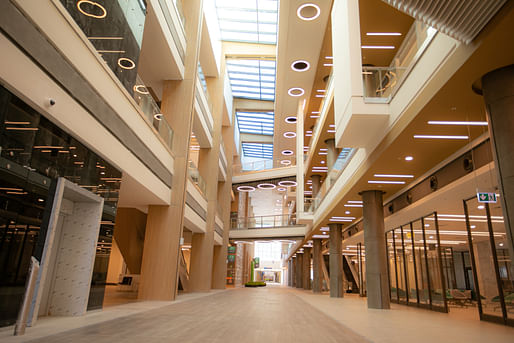

A recently inaugurated 1 million-square-meter hospital complex designed by Arup, Perkins and Will, and Yazgan Design Architecture for Rönesans Holding and Sojitz Corporation in Istanbul, Turkey is a feat of engineering and design coordination.

The massive Başakşehir Pine and Sakura City Hospital complex consists of three nearly identical hospital towers containing a main hospital facility, a psychiatric hospital, and a physical treatment and rehabilitation facility. The 2,682-bed hospital, developed as a public-private partnership, also includes six clinic buildings and five auxiliary facility buildings situated on the site.
While the massing, articulation, and materiality of the complex are relatively staid and straightforward, its what lies underneath these elements that truly defines the complex.
For example, the hospital sits on 2,068 seismic isolators that were designed to help the complex weather the regular earthquakes that rock the region. This approach, in which mechanisms attached to the building foundations counteract the energy waves emanating from the earth during an earthquake, makes the project, according to the architects, the world's largest base isolated building.


In working to arrive at the final design for the hospital complex, Arup engineers turned to cloud computing software to help test the hundreds of structural schemes employed by the project. Typically, engineers rely on algorithms and other "hardware firepower"-heavy calculation approaches to painstakingly test the locations and configurations of concrete structural walls and to model how each of the isolators will respond to different types and intensities of seismic activity. For this project, Arup took to the cloud in order to "transform traditional workflows" by using LS-DYNA simulation software and cloud computing to "expedite the non-linear analysis workflow by 50% in comparison with traditional non-cloud-based workflows," the designers write.

The approach allowed the structural design team to cut design time for this portion of the project from a typical seven months down to just two months' time.
Atila Zekioglu, ARUP Principal explains: "Our digital and cloud-based workflows expedited the process from the concept phase through documentation, facilitating the completion of the design of the hospital within one year and significantly reducing the amount of time typically associated with such large-scale projects."

Zekioglu continues, "Ultimately, the design aims to ensure that the hospital can remain operational after an earthquake, allowing for critical and life-saving services for its patients and adding to the overall resiliency of Başakşehir and İstanbul."
As a result, the structure will be able to withstand and reopen after what's known as a "Maximum Considered earthquake," a 2,500-year event.
No Comments
Block this user
Are you sure you want to block this user and hide all related comments throughout the site?
Archinect
This is your first comment on Archinect. Your comment will be visible once approved.